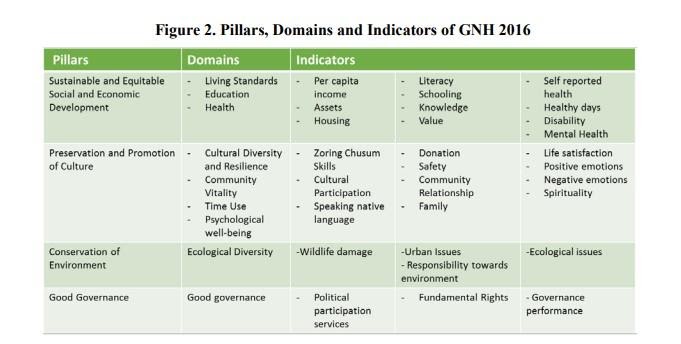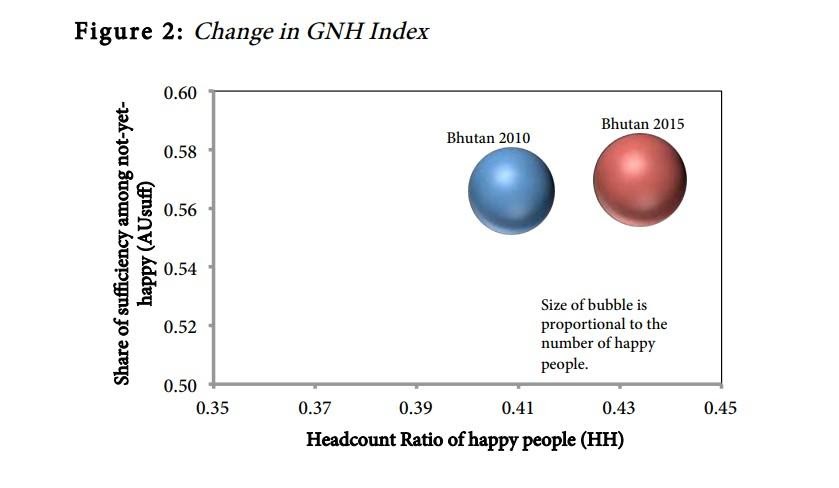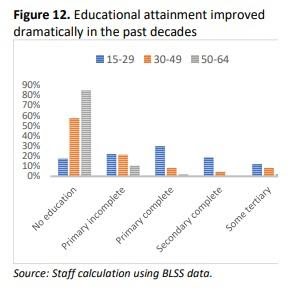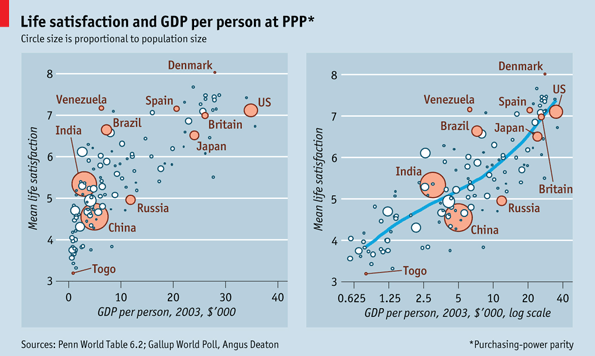
CHAZEL HAKIM – MARCH 2ND, 2021
EDITOR: SEAN O’CONNELL
Situated deep in the eastern Himalayan mountains, Bhutan is often overshadowed by its more prominent neighbors: China and India. But, despite its quiet status, the country has constantly made headlines for a variety of socioeconomic achievements. Bhutan remains, for example, the first and only carbon-negative country in the world, and they have also recently prevented the COVID-19 pandemic from overwhelming its population, with only one Bhutanese citizen passing away from the virus to date.
Nevertheless, it is the Gross National Happiness Index (GNH), Bhutan’s main macroeconomic indicator, that stands as the country’s most radical achievement to date. The GNH’s construction is simple: rather than measuring the aggregate spending from a country’s population, Bhutan’s GNH seeks to measure their total happiness. The “happiness” in this case is obviously a subjective concept, but the indicators for GNH are based on tangible statistics of measures ranging from economic development to environmental protection levels.
Bhutan is also not the only country to have shifted macroeconomic analysis towards more holistic social indicators, as several other countries such as the United Kingdom and New Zealand have incorporated wellness goals into their policies. However, no country has put the ideas of happiness as central to their public policy decisions as Bhutan does through their GNH. Particularly with the country’s recent success during the pandemic, it then might be worthwhile to ask: has GNH actually played a significant role in helping Bhutan thrive?
Bhutan’s Gross National Happiness Index
The idea of a GNH index stretches back to 1972, when one of the founders of the European Union, Sicco Mansholt, first came up with the idea as a critical response to the world’s traditional budget reliance on Gross Domestic Product (GDP). For those unfamiliar with GDP, it is simply a measure of the monetary value of a country’s spending on goods and services, but its real worth lies in its use as an quantitative indicator of a country’s growth and national income. Policymakers rely on GDP to make informed decisions about policy, but over the years, many have criticized how GDP calculations ignore crucial aspects of people’s lives, including life-satisfaction and environmental degradation metrics (read this BER article for a detailed explanation of criticisms of GDP).
Compared to GDP’s technical measures of spending and output, Bhutan’s own GNH index takes a more holistic approach to measuring a country’s growth. One of its most striking differences comes down to its equal weighting of economic and non-economic aspects of the country, as exemplified by the four pillars that the GNH index encompasses: sustainable and equitable development, conservation of the environment, preservation and promotion of culture, and good governance. One can break down the index even further into nine domains, which range from living standards to time usage (Figure 1).

Figure 1: Pillars, Domains, and Indicators of GNH 2016
Source: Centre for Bhutan Studies, Columbia University (2016)
In terms of the actual logistics, the GNH index consists of a decile numbered range from 0 to 1, calculated from a cross-sectional survey sent out to a random sample of the Bhutanese people once every five years, including 2008 (the pilot survey year), 2010, and 2015. The survey itself is structured in terms of the nine domains and contains around 148 variables—both qualitative and quantitative. Its data analysis specifically relies on poverty-measuring methods developed by Oxford University researchers Sabina Alkrie and James Foster. In short, however, The 2015 GNH report explains the GNH’s final tally quite nicely by defining the following equation:
GNH = HH + (HU * AsuffU)
where HH is the rate or headcount of “happy” people, Hu is the rate of “not-yet-happy” people (i.e. the complement of HH ), and AsuffU is the average percentage of domains in which the not-yet happy-people have sufficient achievements. In other words, the GNH is the total rate of happy people plus the extent that not-yet-happy people “enjoy” their lives.
Does the GNH Index Work?
Consequently, legislation that now passes through the Bhutanese government must be filtered through a “GNH policy lens,” so, since 2008, every policy decision has operated under the pretense of raising GNH rather than GDP. Based on this criteria alone, one might conclude that Bhutan’s public policy has moved towards effectively interpreting and addressing information from the GNH index. Indeed, GNH has increased from 0.743 in 2008 to 0.756 in 2015, a “statistically significant increase” by the 2015 GNH report (Figure 2). However, this conclusion is analytically insufficient, and more concrete evidence might be helpful.

Figure 2: Changes in the GNH Index
Source: 2015 GNH Survey Report, Center for Bhutan & GNH Studies (2015)
A better method to analyze GNH might be to observe how different variables in Bhutan have changed since the “GNH policy lens” became a guiding force of public policy. One of the most striking facts in this vein is that Bhutan, according to a World Bank report, has been able to cut poverty from 36 to 12 percent between the years 2007 and 2017: the steepest decline in poverty of any of its neighboring South Asian countries over that time. Furthermore, enrollment in both primary and secondary education has significantly increased, with the former jumping up by 30 percentage points between 2007 and 2017. And in terms of infrastructure, 91 percent of the Bhutanese population now lives within a one hour distance to a health facility compared to just 73 percent in 2007, while increased public investment has led to farm road networks to jump from 1700 km to 11200 km between 2008 and 2017.
However, this is still not conclusive as to whether the GNH caused all these changes for Bhutan. One of the most obvious criticisms of these numbers may be that these trends started before the implementation of GNH in 2008. For example, while educational attainment certainly increased over the past decade in Bhutan, it is easy to see that the trend extends back to the 1990s when comparing the education levels of 50-64 and 30-49 year-olds (Figure 3). Many of the World Bank report statistics, in fact, show positive trends that already follow from before the GNH index arrived. Perhaps Bhutan’s public policy didn’t line up with GNH, but rather GNH was just a product of good public policy.

Figure 3: Educational attainment improved dramatically over the past decades.
Source: Bhutan Systematic Country Diagnosis, World Bank Group (2017)
A Possible Answer in Buddhism
A lack of an evident and significant difference from GNH may not actually be that surprising for Bhutan. Besides the fact that the positive trends might just be a result of sustained economic growth for the low-income country, one crucial aspect that might help make sense of GNH’s passiveness comes from Bhutan’s influence by Buddhist teachings. In fact, Buddhism is the state religion of the country, and about three fourths of the population are considered to be followers. Buddhist notions of collective harmony, both with others and the environment, have played an important role in the policy decisions made by the Bhutanese government.
The country’s GNH is no different in this case. The whole definition of the “happiness” Bhutanese policymakers attempt to maximize in GNH has its roots in the Buddhist idea of cultivating the inner self, which Buddhist monk Khenpo Phunshok Tashi articulates in this paper on Bhutan’s GNH index: “Buddhist philosophy states that relying on such external factors as the source of happiness will only lead to unhappiness. The Buddha advised his followers that if they desired true happiness, they should concentrate on cultivating inner contentment.”
Implicitly, GNH focuses on the material and spiritual well-being of the Bhutanese people for the sake of helping them achieve happiness. The nine domains of GNH even exemplify this Buddhist philosophy: balancing the conventional growth of living standards, for example, as a goal that is just as important as psychological well-being. Therefore, many of Bhutan’s success stories in the past decade might be due not only to GNH but Bhutan’s underlying Buddhist roots of emphasizing personal well-being. The Bhutanese GNH index may therefore just be a mathematical articulation of an attitude that already existed in the country for decades.
Bhutan’s COVID-19 pandemic response illustrates a good case of the collective Buddhist philosophy underlying the country today. The country’s COVID-19 numbers are astoundingly low: a surprising fact given that it only has only around 337 physicians and 3,000 health workers for its population of 760,000 people. But, according to the Director of the Centre for Bhutan & GNH Studies, Karma Ura, that success has depended on the country’s holistic response to the pandemic. The unemployed, for example, have received grants from the country’s king to cover a year’s worth of income, but private sector banks have also decided to forgive interest rates for six months. As Ura promptly puts, “this could only happen in a Buddhist country.”
Conclusion
Even if it is difficult to pinpoint whether many of Bhutan’s success stories have originated from GNH, it might be natural to ask whether other countries should adopt a similar, more holistic approach to economic development. In fact, there have already been attempts in smaller regions around the world to replicate the GNH index measurement, including the cities of Victoria, São Paulo, and Seattle. In 2011, the United Nations even published a resolution urging other countries to readjust their economic goals in terms of happiness, with Bhutan’s GNH included as an example.
However, focusing on administrative reform away from GDP and towards a GNH-type index might be missing the bigger principle. The concern is not whether a well-being index can fit a country’s macroeconomic goals but rather the converse. Adopting a GNH index may have been a natural consequence of Bhutan’s collective and spiritual values, and the country could perhaps perform just as well without one. On the other hand, for countries whose cultural values differ greatly from Bhutan’s, it could be more difficult to implement a development index solely based on the abstract value of happiness.
If policymakers in other countries want to take a step in a direction similar to Bhutan, they would first need to find common ground on both the economic and social priorities. It is a daunting task, but Bhutan has shown this to be an achievable goal. Other countries might therefore be best served by looking to GNH not necessarily as a model to copy, but as a guide for how measuring socioeconomic prosperity can be redefined.
Featured Image Source: Geographic Expedition Adventure
Disclaimer: The views published in this journal are those of the individual authors or speakers and do not necessarily reflect the position or policy of Berkeley Economic Review staff, the Undergraduate Economics Association, the UC Berkeley Economics Department and faculty, or the University of California, Berkeley in general.



